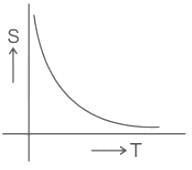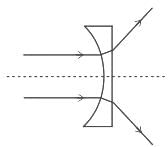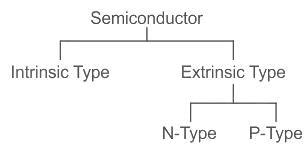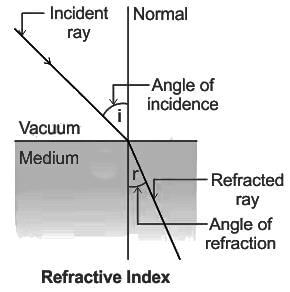Physics: CUET Mock Test - 3 - CUET MCQ
30 Questions MCQ Test - Physics: CUET Mock Test - 3
Which of the following graph correctly represents the variation of resistivity 's' with temperature 'T' for a semiconductor material ?
A proton and an alpha particle moving with same kinetic energy enter in the region of uniform magnetic field perpendicular to it. The ratio of radii of their trajectories will be:
A plano-concave lens of focal length 10 cm is cut vertically in to two equal parts then the power of each part is equal to_______ .
Which of the following is not an example of a semiconductor material?
If the refractive index of water is 4/3 and that of glass is 5/3, then the critical angle of incidence for light tending to go from glass to water is:
Consider the following statements regarding electric dipole:
1. The SI unit for electric dipole moment is coulomb/meter
2. Its magnitude is equal to the product of the charge and the distance between the charges.
3. Its magnitude decreases with increasing distance between charges
Which of the above statement(s) is/are correct
In a metre bridge experiment, null point is obtained at 20 cm from one end of the wire when resistance X is balanced against another resistance Y. If X<Y, then where will be the new position of the null point from the same end, if one decides to balance a resistance of 4X against Y ?
Potentiometer measures the potential difference more accurately than a voltmeter, because
A piece of copper and another of germanium are cooled from room temperature to 80K. The resistance
In electromagnetic waves the ratio of amplitudes of electric field and magnetic field is equal to
Which of the following is not a use of electromagnetic wave?
Which colour of the visible spectrum has the greatest wavelength?
The electric field for an em wave is: E = E0sin[(12 x 1015 t – 4 x 107 x)]. What is the speed of the em waves?
Which among the following is true about transformers?
A bar of length 0.7 m slides along metal rails at a speed of 1 m/s. The bar and rails are in a magnetic field of 20 T, pointing out into the page. Calculate the motional emf.
In which type of circuit the value of power factor will be minimum?
Which among the following varies in both magnitude and sign over a cycle?
A bar of length 0.15 m slides along metal rails at a speed of 5 m/s. The bar and rails are in a magnetic field of 40 T, pointing out into the page. The resistance of two resistors in parallel is both 20 Ω, and the resistance of the bar is 5 Ω. What is the current in the bar?
What happens to the frequency and the wavelength when light passes from a rarer to a denser medium?
What is the relative refractive index of water with respect to glass?
A metal rod is forced to move with constant velocity along two parallel metal rails, connected with a strip of metal at one end across a magnetic field (B) of 0.5 T, pointing out of the page. The rod is of length 45 cm and the speed of the rod is 70 cm/s. The rod has a resistance of 10 Ω and the resistance of the rails and connector is negligible. What is the rate at which energy is being transferred to thermal energy?
Identify the type of materials which have resistivities in the range of 10-8 Ωm to 10-6 Ωm.
What is the power factor in a pure resistive circuit?
Identify the material whose resistivity is more than 1014 Ωm.











 --- (1)
--- (1)







 --- (1)
--- (1) --- (2)
--- (2)



 1.11
1.11
















